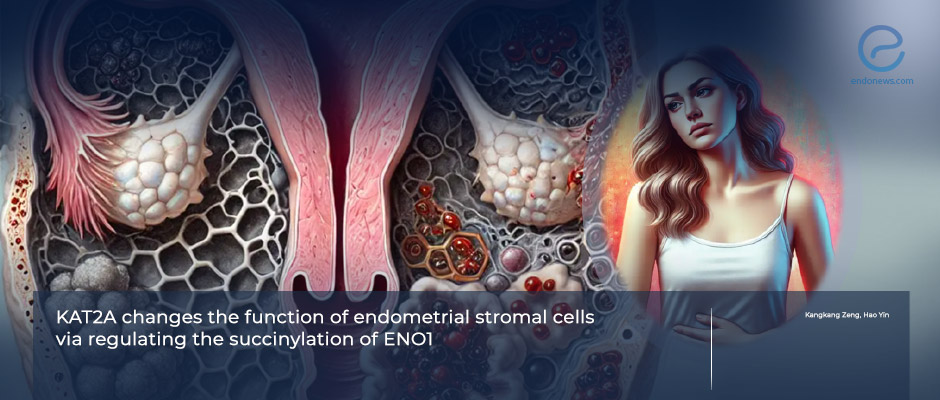Endometrial Stromal Cell Function: The role of Histone acetyltransferase and Alpha-Enolase
Nov 19, 2024
KAT2A-Driven ENO1 Succinylation Alters Endometrial Stromal Cell Function
Key Points
Highlight
- The role of Histone acetyltransferase KAT2A is significantly overexpressed in endometriosis, plays a pivotal role in promoting endometrial stromal cell proliferation, migration, invasion and also inhibits apoptosis.
- Furthermore, KAT2A mediates the succinylation and activation of Alpha-Enolase ENO1, further enhancing the aggressive behavior of endometrial stromal cells.
Importance
- Succinylation and its regulatory genes are important in the pathogenesis of endometriosis .
- Their gene interaction provides a deeper understanding of the molecular mechanisms underlying endometriosis and sheds light on the potential of targeting succinylation pathways as diagnostic biomarkers for diagnosis and treatment.
What’s done here?
- This study used endometrial stromal cells from patients with endometriosis, cultured under controlled conditions, and transfected with Histone acetyltransferase (KAT2A)-targeting shRNA or overexpression vectors.
- Various assays, including RT-qPCR, Western blot, and immunofluorescence, were performed to analyze gene and protein expression, as well as KAT2A-ENO1 interaction through co-immunoprecipitation. Functional analyses, such as CCK-8 for cell viability, flow cytometry for apoptosis, and Transwell assays for migration and invasion, were conducted to evaluate the impact of KAT2A and ENO1 on ESC behavior.
Key results
- This study found that KAT2A expression was significantly increased in endometriotic tissues compared to control tissues, promoting the proliferation, migration, and invasion of ESCs while inhibiting apoptosis.
- KAT2A modulated the succinylation and expression of ENO1, with a strong reciprocal interaction between the two proteins, as shown by co-immunoprecipitation and immunofluorescence.
- Overexpression of ENO1 reversed the effects of KAT2A silencing, confirming that KAT2A regulates ESC malignancy via ENO1 modulation.
Limitations
- This was limited by having only one cell line used and lacking animal experiments.
- It is still unclear how KAT2A interacts with ENO1 to function as a transcriptional agent, which is interesting and important. In addition, succinylation as a protein modification of lysine may affect ubiquitination degradation or phosphorylation, or affect protein modification at other sites.
Lay Summary
In a study published in the Open Life Sciences, Yin et. al investigated how KAT2A-driven ENO1 succinylation affects the function of endometrial stromal cells in endometriosis, highlighting its role in disease progression and its potential as a target for therapeutic intervention.
The study highlights the pivotal role of KAT2A-mediated succinylation of ENO1 in the progression of endometriosis. KAT2A ia also called lysine acetyltransferase 2A, is a transcriptional activator and also has role on stem cell renewal. Enolase-1(ENO1) is a glycolytic enzyme that plays role in cancer development, regulates stem cell-like properties and also promotes inflammatory response.
Analysis of ectopic endometrial tissues revealed a significant upregulation of KAT2A compared to eutopic tissues, as confirmed by qRT-PCR and Western blot. KAT2A silencing in ESCs reduced cell proliferation, migration, and invasion while promoting apoptosis, emphasizing its role in enhancing the proliferation of ESCs. Additionally, KAT2A was found to regulate ENO1 succinylation and expression, with co-immunoprecipitation and immunofluorescence demonstrating their direct interaction. ENO1 overexpression reversed the inhibitory effects of KAT2A silencing, further corroborating the regulatory role of KAT2A in ESC behavior.
This research provides new insights into the pathogenesis of endometriosis, identifying KAT2A and ENO1 as potential therapeutic targets. The findings suggest that targeting KAT2A-driven succinylation processes may be a promising avenue for treating endometriosis by impairing the malignant behavior of ESCs.
Future studies should include multiple cell lines and animal models to validate the molecular mechanisms and therapeutic potential of KAT2A-ENO1 modulation in endometriosis. Further exploration of how succinylation affects other post-translational modifications may provide a more comprehensive understanding of the disease.
Research Source: https://pubmed.ncbi.nlm.nih.gov/38585644/
endometriosis embryonic stem cells KAT2A ENO1

